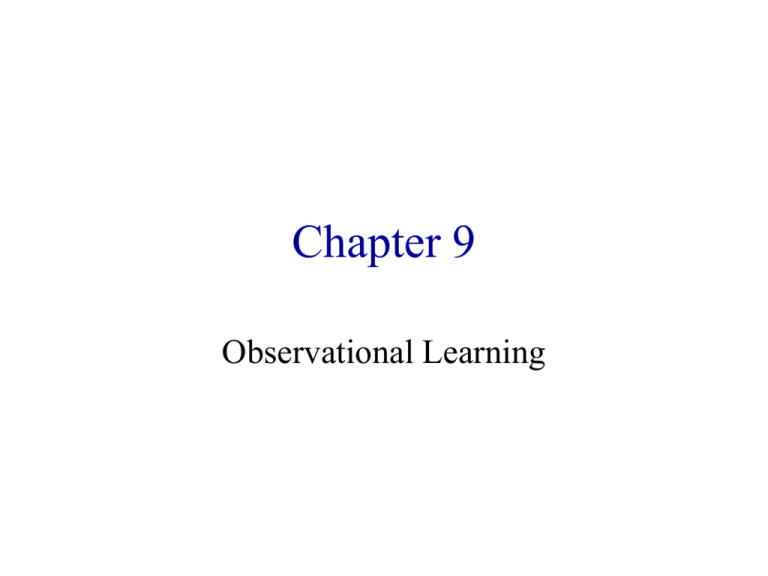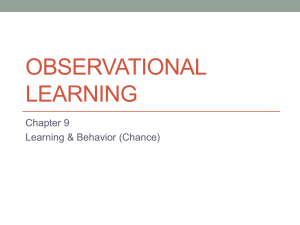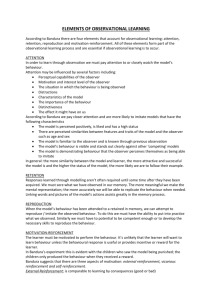Chapter 5
advertisement

Chapter 9 Observational Learning Of Octopuses and Crabs • • • • • Octopus Crab Put crab in jar Octopus opens jar http://www.youtube.co m/watch?v=ocWF6d0 nelY Uh-oh! Time to open jar Results Trials Observation • Second octopus watches training of first octopus Time to open jar First (model) Second (observer) Trials Observational Learning • Also called “Vicarious Learning” • A change in behaviour due to the experience of observing a model Early Work on Observational Learning • Anecdotal evidence • Thorndike – Puzzle box – Experienced model, naïve learner – Animals don’t learn by observation • Successes and failures Imitative Behaviour • Not necessarily the same as observational learning • Do same thing as a model • May indicate a lack of learning about a situation – E.g., doing a behaviour that leads to an aversive outcome Human Infants & Imitation • At what age can humans imitate/learn vicariously? • Metzolff & Moore (1977) – 12 to 21 day old infants – Facial gestures: tongue protrusion, mouth open, lip protrusion Experiment • • • • • Experimenter: 90 sec passive face (baseline) Infant shown gesture four times Imitation-test period Video taped and scored by “blind” judges Supports imitation % of mouth open response % of tongue-out response Results 50 25 baseline tongue-out mouth open Experimenter’s Gesture 10 5 baseline tongue-out mouth open Experimenter’s Gesture Infant Research • Replication difficult – Tongue protrusion elicited by other means – Infants’ attention: general arousal? • Evolutionary advantage • Observing and copying behaviour of parents, siblings, etc. may bring more attention What can you Learn with Observational Learning? • Classical conditioning: no • Operant conditioning:yes • Observe model’s outcome (appetitive or aversive) Epstein (1984) • Model bird (MB) – Experienced • Observer bird (OB) – Naïve • Experiment – Model trained to use object for food – Ball (B), switch (S), key (K); five phases Five Phases • • • • • 1. OB right; B, S, K in left baseline 2. OB right; B, S, K in right 3. MB in left, OB in right; B, S, K in left 4. As above, but B, S, K in right 5. OB right; B, S, K in right Results • Phase 4: observer imitates model • Phase 5: observer uses objects without model to guide actions • Learning due to observation of a model and expectation of reinforcement (motivation; latent learning) • Not due to observer’s prior experience or direct reinforcement Levy, McClinton, Rabinowitz & Wolkin (1974) • Children observed model look at paired pictures, indicating preferences • Model received approval, disapproval, or neutral consequences • Observers’ subsequent preferences were for the pictures that the models received approval for selecting Generalized Imitation • Don’t see the outcome of the model’s behaviour, but the observer imitates anyway • Prior experience with observational learning • We learn that imitating others’ behaviour may provide reinforcement • We generalize from one condition to another Generalized Imitation • Also an issue of discrimination as applied to: • Discriminative stimulus – Who to imitate • Response – When to imitate • Outcome – What to expect Miller-Dollard Reinforcement Theory • Observational learning as a subset of operant conditioning • Observer’s behaviour changes due to consequences of observer’s behaviour, not the model’s Process • Three steps: – 1. Learner observes behaviour of model – 2. Learner copies response – 3. Learner receives reinforcement --> continue imitating • Model rat knows maze; observer allowed to follow – Group 1: both model & observer reinforced at end; observer will run maze on own – Group 2: only model reinforced at end; observer will not run maze (latent learning) Interesting Issues • When to delay before imitating – Learning and telling a joke – Limited time offer (e.g., trick-or-treating) • Lack of reinforcement – May not actually observe model’s outcome – Model’s outcome may be on PRE – Imitation may not lead to immediately appetitive outcome – Generalized imitation Bandura’s Studies • Bobo the Clown experiments • Children as observers • Watched various models demonstrating behaviours • Consequences of model’s behaviour • Availability of reward/punishment Model Observers Bandura’s Social Cognitive Theory • • • • Attentional processes Retentional processes Motor reproductive processes Incentive and motivational processes Characteristics of the Model • • • • • Rewardingness Authority Dominance Similarity Sincerity Characteristics of the Learner • Uncertainty • Sex • Age Characteristics of the Situation • Task uncertainty • Task difficulty • Presentation of model Comparison • Miller-Dollard Reinforcement Theory – Behavioural; operant conditioning – Past experiences • Bandura’s Social Learning Theory – Innate processes, learning, and cognition – Future expectations Television Violence • • • • National Television Violence Study (1998) 8000 hours of programming 7 days/week, 6AM-11PM for 3 years 60% of programs contained violence – Less than 4% contained anti-violence message • By age 12, average child has seen 8,000 murders and over 100,000 other acts of violence on TV TV Violence & Aggression • Strong correlation • Adapted from Bushman & Anderson (2000) Smoking & lung cancer TV violence & aggression Condom use and HIV Secondary smoking & lung cancer Lead exposure and child IQ Calcium intake & bone mass Homework & academic achievement -0.2 0 0.2 Correlation 0.4 Issues for Studies • Correlational findings – Do not imply causation – Third factor? • Longitudinal studies – Follow subjects over time • Experimental studies – Control and experimental groups – Contrived? – Brief time period Phobias • Development – Vicarious acquisition – Prevalence in humans? • Treatment – Flooding – Systematic desensitization Observational Learning Treatments • Modeling – Used with the very young – Sometimes more rapid – May be better at generalization • Three types of phobia reduction modeling – 1. Graduated modeling – 2. Participant modeling – 3. Symbolic modeling Modeling in Behaviour Therapy • • • • A model can influence an observer Facilitate known response Teach new behaviours Reduce/eliminate undesirable behaviours Mirror Neurons • Scattered throughout premotor cortex, centres for language, empathy, pain • Fire when certain actions are preformed by or observed in someone else • “Mental imitation” of witnessed (or heard) actions Discovery • Giacomo Rizzolatti, Vitorio Gallese, & Leonardo Fogassi • “Raisin incident” • Macaque monkey with electrodes in premotor cortex • Published in 1996 Locations in Humans • More mirror neurons in more places than in monkeys • Premotor cortex (movement) • Inferior parietal areas (perception) • Posterior parietal lobe, superior temporal sulcus, & insula (comprehend another’s feelings, understand intention, and use language) Role • Learning through observation • Understanding meaning or intention of action • E.g., become better at golf by watching golf • Not limited to motor responses Gallese, Rizolatti, et al. (2005) • Subjects listened to sentences describing actions • Same mirror neurons fired as would have if subjects had done the action or seen the action performed • Mirror neurons responded to abstract representation (i.e., language)






